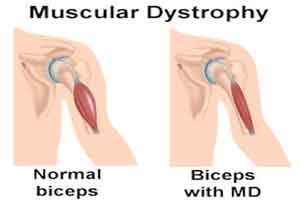- Home
- Editorial
- News
- Practice Guidelines
- Anesthesiology Guidelines
- Cancer Guidelines
- Cardiac Sciences Guidelines
- Critical Care Guidelines
- Dentistry Guidelines
- Dermatology Guidelines
- Diabetes and Endo Guidelines
- Diagnostics Guidelines
- ENT Guidelines
- Featured Practice Guidelines
- Gastroenterology Guidelines
- Geriatrics Guidelines
- Medicine Guidelines
- Nephrology Guidelines
- Neurosciences Guidelines
- Obs and Gynae Guidelines
- Ophthalmology Guidelines
- Orthopaedics Guidelines
- Paediatrics Guidelines
- Psychiatry Guidelines
- Pulmonology Guidelines
- Radiology Guidelines
- Surgery Guidelines
- Urology Guidelines
Targeted therapy for sleep disorders helps patients with muscular dystrophy

Myotonic dystrophy type 1 (DM1) is the most common adult muscular dystrophy, and many patients with DM1 suffer from various sleep and respiratory disorders. In a study in the current issue of the Journal of Neuromuscular Diseases, researchers found that because there is wide range of sleep problems, treatments do not fit a "one size fits all" model.
According to lead investigator Sophie D. West, MD, Newcastle Regional Sleep Service, Newcastle upon Tyne Hospitals NHS Trust, Newcastle upon Tyne, UK, "Excessive daytime sleepiness is a common problem for people with myotonic dystrophy, affecting between 33% and 80% of patients. Other contributing causes can be attributed to poor sleep patterns, obstructive sleep apnea (OSA), respiratory failure, periodic limb movements during sleep, or narcolepsy features."
From May 2011 until May 2015, all patients with DM1, who exhibited symptoms of daytime sleepiness at their annual review at the John Walton Muscular Dystrophy Research Centre, Newcastle upon Tyne, were referred for overnight sleep assessment. For 120 people with DM1, the researchers found that 18% had OSA, 27% had respiratory failure, and 30% had intrinsic sleepiness according to the Epworth Sleepiness Score (ESS).
Patients were divided into four groups, those with OSA, those with daytime respiratory failure, those with ESS, and a control group with no sleep-related symptoms. Treatments were matched to the observed symptoms, which included continuous positive airway pressure (CPAP) for OSA, non-invasive ventilation (NIV) for respiratory failure, and modafinil for excessive daytime sleepiness.
Overall, only 29% of patients studied benefited from the therapies and continued them. This result is lower than would be expected in other patient groups. It suggests that further research studies are needed to help determine which DM1 patients are likely to benefit most from targeted therapy and the most effective ways to deliver these therapies to them.
Based on these results, the investigators recommend a standard classification of DM1 patients into three sleep disturbance types to better target therapies. For patients with high ESS, but no restless leg syndrome or sedative use, modafinil is indicated. For OSA with no daytime respiratory failure, CPAP should be tried. For those with daytime respiratory failure and an abnormal sleep study, NIV is recommended.
Myotonic dystrophy is a heterogeneous disorder, with varying degrees of sleepiness, muscular, and respiratory impairment. Dr. West comments that, "This is valuable data for those people in the myotonic dystrophy community with excessive sleepiness, to support them in having detailed sleep tests and targeted individualized therapies, hopefully to improve their symptoms."

Disclaimer: This site is primarily intended for healthcare professionals. Any content/information on this website does not replace the advice of medical and/or health professionals and should not be construed as medical/diagnostic advice/endorsement or prescription. Use of this site is subject to our terms of use, privacy policy, advertisement policy. © 2020 Minerva Medical Treatment Pvt Ltd